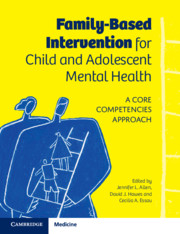37 results
Epidemiology and genomics of a slow outbreak of methicillin-resistant Staphyloccus aureus (MRSA) in a neonatal intensive care unit: Successful chronic decolonization of MRSA-positive healthcare personnel
-
- Journal:
- Infection Control & Hospital Epidemiology / Volume 44 / Issue 4 / April 2023
- Published online by Cambridge University Press:
- 16 June 2022, pp. 589-596
- Print publication:
- April 2023
-
- Article
- Export citation
38460 Independent Investigator Incubator (I3) yields external funding within three years for the majority of junior faculty
-
- Journal:
- Journal of Clinical and Translational Science / Volume 5 / Issue s1 / March 2021
- Published online by Cambridge University Press:
- 30 March 2021, p. 64
-
- Article
-
- You have access
- Open access
- Export citation
Part I - Theoretical Perspectives on Family-Based Intervention
-
- Book:
- Family-Based Intervention for Child and Adolescent Mental Health
- Published online:
- 18 February 2021
- Print publication:
- 11 March 2021, pp 1-52
-
- Chapter
- Export citation
Part V - New Developments in Family-Based Intervention
-
- Book:
- Family-Based Intervention for Child and Adolescent Mental Health
- Published online:
- 18 February 2021
- Print publication:
- 11 March 2021, pp 269-303
-
- Chapter
- Export citation
Copyright page
-
- Book:
- Family-Based Intervention for Child and Adolescent Mental Health
- Published online:
- 18 February 2021
- Print publication:
- 11 March 2021, pp iv-iv
-
- Chapter
- Export citation
Chapter 2 - The Role of the Family in Child and Adolescent Psychopathology
- from Part I - Theoretical Perspectives on Family-Based Intervention
-
-
- Book:
- Family-Based Intervention for Child and Adolescent Mental Health
- Published online:
- 18 February 2021
- Print publication:
- 11 March 2021, pp 14-28
-
- Chapter
- Export citation
Index
-
- Book:
- Family-Based Intervention for Child and Adolescent Mental Health
- Published online:
- 18 February 2021
- Print publication:
- 11 March 2021, pp 304-312
-
- Chapter
- Export citation
Chapter 1 - A Core-Competency Perspective on Family-Based Intervention for Child and Adolescent Mental Health
- from Part I - Theoretical Perspectives on Family-Based Intervention
-
-
- Book:
- Family-Based Intervention for Child and Adolescent Mental Health
- Published online:
- 18 February 2021
- Print publication:
- 11 March 2021, pp 1-13
-
- Chapter
- Export citation
Contributors
-
- Book:
- Family-Based Intervention for Child and Adolescent Mental Health
- Published online:
- 18 February 2021
- Print publication:
- 11 March 2021, pp vii-x
-
- Chapter
- Export citation
Part II - Core Clinical Competencies
-
- Book:
- Family-Based Intervention for Child and Adolescent Mental Health
- Published online:
- 18 February 2021
- Print publication:
- 11 March 2021, pp 53-86
-
- Chapter
- Export citation
Part IV - Family Intervention for Children at Risk Due to Family Dysfunction or Past Adversity
-
- Book:
- Family-Based Intervention for Child and Adolescent Mental Health
- Published online:
- 18 February 2021
- Print publication:
- 11 March 2021, pp 207-268
-
- Chapter
- Export citation
Contents
-
- Book:
- Family-Based Intervention for Child and Adolescent Mental Health
- Published online:
- 18 February 2021
- Print publication:
- 11 March 2021, pp v-vi
-
- Chapter
- Export citation
Preface
-
- Book:
- Family-Based Intervention for Child and Adolescent Mental Health
- Published online:
- 18 February 2021
- Print publication:
- 11 March 2021, pp xi-xii
-
- Chapter
- Export citation
Part III - Family Intervention for Specific Child and Adolescent Mental Health Problems
-
- Book:
- Family-Based Intervention for Child and Adolescent Mental Health
- Published online:
- 18 February 2021
- Print publication:
- 11 March 2021, pp 87-206
-
- Chapter
- Export citation

Family-Based Intervention for Child and Adolescent Mental Health
- A Core Competencies Approach
-
- Published online:
- 18 February 2021
- Print publication:
- 11 March 2021
Context matters: Developing peer reviewers to advance science and practice
-
- Journal:
- Industrial and Organizational Psychology / Volume 13 / Issue 1 / March 2020
- Published online by Cambridge University Press:
- 01 May 2020, pp. 57-60
-
- Article
- Export citation
Earlier age at menarche as a transdiagnostic mechanism linking childhood trauma with multiple forms of psychopathology in adolescent girls
-
- Journal:
- Psychological Medicine / Volume 50 / Issue 7 / May 2020
- Published online by Cambridge University Press:
- 25 April 2019, pp. 1090-1098
-
- Article
- Export citation
Against the 1989–1990 Ending Myth
-
- Journal:
- Central European History / Volume 52 / Issue 1 / March 2019
- Published online by Cambridge University Press:
- 27 March 2019, pp. 125-147
- Print publication:
- March 2019
-
- Article
-
- You have access
- HTML
- Export citation
Zika Virus Preparedness and Response Efforts Through the Collaboration Between a Health Care Delivery System and a Local Public Health Department
-
- Journal:
- Disaster Medicine and Public Health Preparedness / Volume 12 / Issue 6 / December 2018
- Published online by Cambridge University Press:
- 07 March 2018, pp. 689-691
-
- Article
- Export citation
Beyond HR Competencies: Removing Organizational Barriers to Maximize the Strategic Effectiveness of HR Professionals
-
- Journal:
- Industrial and Organizational Psychology / Volume 10 / Issue 1 / March 2017
- Published online by Cambridge University Press:
- 23 March 2017, pp. 42-50
-
- Article
- Export citation



